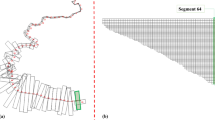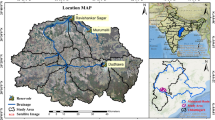Abstract
Reservoir hydrodynamic and water quality modeling, in conjunction with the monitoring programs, is one of the essential tools for controlling the pollution of these types of water bodies. The complexity of the model, data scarcity, and the variable nature of natural phenomena lead to uncertainty in models, which should be considered in the calibration process of these models. Uncertainty-based automatic calibration is one of the methods that can be effective in achieving a high-reliability model. In this paper, the Sequential Uncertainty Fitting (SUFI-2) algorithm was used for the automatic calibration of the two-dimensional hydrodynamic and water quality model (CE-QUAL-W2) for the reservoir under parameter uncertainty conditions. To this end, the CE-QUAL-W2 model was developed to simulate the temperature and water surface elevation of the Karkheh Dam reservoir (western Iran). The parameters affecting temperature were regarded as uncertain parameters in the calibration process, including the coefficients of longitudinal eddy viscosity, longitudinal eddy diffusivity, Chezy coefficient or Manning, wind sheltering, solar radiation absorbed in the surface layer, extinction coefficient for pure water, and the experimental coefficients of wind speed function. The developed method demonstrated a high potential for matching the simulated temperature and water surface elevation for the reservoir with the measured data. Averagely, 69% of the simulated temperature and 90% of the simulated water surface elevation were located within the 95% confidence interval. The SUFI-2 algorithm also showed better performance in terms of the convergence rate compared with the particle swarm optimization (PSO) algorithm, which indicated a lower number of calls (80 calls compared to 2000 calls) and could reduce the total root-mean-square error by 9.6%.







Similar content being viewed by others
References
Abbaspour, K. C. (2008). Swat-Cup2: SWAT Calibration and Uncertainty Programs Manual Version 2. Switzerland: Duebendorf.
Abbaspour, K. C., van Genuchten, M. T., Schulin, R., & Schläppi, E. (1997). A sequential uncertainty domain inverse procedure for estimating subsurface flow and transport parameters. Water Resources Research, 33(8), 1879–1892. https://doi.org/10.1029/97WR01230.
Abbaspour, K. C., Johnson, C. A., & van Genuchten, M. T. (2004). Estimating uncertain flow and transport parameters using a sequential uncertainty fitting procedure. Vadose Zone Journal, 3(4), 1340–1352. https://doi.org/10.2113/3.4.1340.
Abbaspour, K. C., Yang, J., Maximov, I., Siber, R., Bogner, K., Mieleitner, J., Zobrist, J., & Srinivasan, R. (2007). Modelling hydrology and water quality in the pre-alpine/alpine Thur watershed using SWAT. Journal of Hydrology, 333(2–4), 413–430. https://doi.org/10.1016/j.jhydrol.2006.09.014.
Afshar, A., Kazemi, H., & Saadatpour, M. (2011). Particle swarm optimization for automatic calibration of large scale water quality model (CE-QUAL-W2): Application to Karkheh Reservoir, Iran. Water Resources Management, 25(10), 2613–2632. https://doi.org/10.1007/s11269-011-9829-7.
Afshar, A., Masoumi, F., & Sandoval Solis, S. (2018). Developing a reliability-based waste load allocation strategy for river-reservoir systems. Journal of Water Resources Planning and Management, 144(9), 04018052. https://doi.org/10.1061/(ASCE)WR.1943-5452.0000973.
Ambrose, R., Wool, T., Connolly, J., & Schanz, R. (1987). WASP4, a hydrodynamic and water quality model-model theory, user’s manual, and programmers’ guide. U.S. Environmental Protection Agency, Washington, D.C., EPA/600/3–87/039 (NTIS PB88185095)
Cao, Y., Zhang, J., Yang, M., Lei, X., Guo, B., Yang, L., Zeng, Z., & Qu, J. (2018). Application of SWAT model with CMADS data to estimate hydrological elements and parameter uncertainty based on SUFI-2 algorithm in the Lijiang river basin, China. Water, 10(6), 742. https://doi.org/10.3390/w10060742.
Cole, T. M., & Wells, S. (2000). CE-QUAL-W2: A two-dimensional, laterally averaged, Hydrodynamic and Water Quality Model, Version 3.0. Instruction Report EL-2000.
Eberhart, R., & Kennedy, J. (1995). A new optimizer using particle swarm theory. In Micro Machine and Human Science, 1995. MHS’95., Proceedings of the Sixth International Symposium on (pp. 39–43). IEEE.
Finley, J. R., Pintér, J. D., & Satish, M. G. (1998). Automatic model calibration applying global optimization techniques. Environmental Modeling & Assessment, 3(1), 117–126. https://doi.org/10.1023/A:1019010822186.
Hasanzadeh, S. K., Saadatpour, M., & Afshar, A. (2020). A fuzzy equilibrium strategy for sustainable water quality management in river-reservoir system. Journal of Hydrology, 586, 124892. https://doi.org/10.1016/j.jhydrol.2020.124892.
Hodges, B., & Dallimore, C. (2001). Estuary and lake computer model, ELCOM, science manual, code version 1.5.0.
Huo, A., Huang, Z., Cheng, Y., & Van Liew, M. W. (2020). Comparison of two different approaches for sensitivity analysis in Heihe River basin (China). Water Supply, 20(1), 319–327.
Kamali, B., Abbaspour, K. C., Lehmann, A., Wehrli, B., & Yang, H. (2018). Uncertainty-based auto-calibration for crop yield – the EPIC+ procedure for a case study in Sub-Saharan Africa. European Journal of Agronomy, 93, 57–72. https://doi.org/10.1016/j.eja.2017.10.012.
Masoumi, F., Afshar, A., & Palatkaleh, S. T. (2016). Selective withdrawal optimization in river–reservoir systems; trade-offs between maximum allowable receiving waste load and water quality criteria enhancement. Environmental Monitoring and Assessment, 188(7), 390. https://doi.org/10.1007/s10661-016-5386-0.
Masoumi, F., Najjar-Ghabel, S., & Safarzadeh, A. (2019). Automatic calibration of groundwater simulation model (MODFLOW) by indeterministic SUFI-II algorithm. Amirkabir Journal of Civil Engineering (in Persian), https://doi.org/10.22060/CEEJ.2019.16990.6426
McKay, M. D., Beckman, R. J., & Conover, W. J. (1979). Comparison of three methods for selecting values of input variables in the analysis of output from a computer code. Technometrics, 21(2), 239–245.
Mousavi, S. J., Abbaspour, K. C., Kamali, B., Amini, M., & Yang, H. (2012). Uncertainty-based automatic calibration of HEC-HMS model using sequential uncertainty fitting approach. Journal of Hydroinformatics, 14(2), 286–309.
Ng, A., & Perera, B. (2000). Importance of genetic algorithm operators in river water quality model parameter optimization. In: Proceedings of the 26th hydrology and water resources symposium (pp. 773–778). Perth, Australia.
Ostfeld, A., & Salomons, S. (2005). A hybrid genetic instance based learning algorithm for CE-QUAL-W2 calibration. Journal of Hydrology, 310(1–4), 122–142. https://doi.org/10.1016/j.jhydrol.2004.12.004.
Perin, R., Trigatti, M., Nicolini, M., Campolo, M., & Goi, D. (2020). Automated calibration of the EPA-SWMM model for a small suburban catchment using PEST: a case study. Environmental Monitoring and Assessment, 192(6), 374.
Poeter, E. P., & Hill, M. C. (1997). Inverse models: a necessary next step in groundwater modeling. Ground Water, 35(2), 250–260. https://doi.org/10.1111/j.1745-6584.1997.tb00082.x.
Porreza Bilondi, M., Abbaspour, K. C., & Ghahraman, B. (2013). Application of three different calibration-uncertainty analysis methods in a semi-distributed rainfall-runoff model application. Middle East Journal of Scientific Research, 15(9), 1255–1263.
Press, W. H., Flannery, B. P., Teukolsky, S. A., & Vetterling, W. T. (1992). The Art of Scientific Computing. Numerical Recipes. Cambridge: Cambridge University. https://doi.org/10.2307/1269484.
Saadatpour, M. (2020). An adaptive surrogate assisted CE-QUAL-W2 model embedded in hybrid NSGA-II_ AMOSA algorithm for reservoir water quality and quantity management. Water Resources Management, 34, 1437–1451. https://doi.org/10.1007/s11269-020-02510-x.
Shen, J., & Kuo, A. Y. (1998). Application of inverse method to calibrate estuarine eutrophication model. Journal of Environmental Engineering, 124(5), 409–418. https://doi.org/10.1061/(ASCE)0733-9372(1998)124:5(409).
Wells, S. A. (2013). CE-QUAL-W2 model and model set-up. In EPA Region 6 Water Quality Workshop and Conference. Dallas TX.
Willey, R. G., Smith, D. J., & Duke, J. H. (1996). Modeling water-resource systems for water-quality management. Journal of Water Resources Planning and Management, 122(3), 171–179. https://doi.org/10.1061/(ASCE)0733-9496(1996)122:3(171).
Yang, J., Reichert, P., Abbaspour, K. C., Xia, J., & Yang, H. (2008). Comparing uncertainty analysis techniques for a SWAT application to the Chaohe Basin in China. Journal of Hydrology, 358(1–2), 1–23.
Author information
Authors and Affiliations
Corresponding author
Additional information
Publisher’s note
Springer Nature remains neutral with regard to jurisdictional claims in published maps and institutional affiliations.
Rights and permissions
About this article
Cite this article
Masoumi, F., Najjar-Ghabel, S. & Salimi, N. Automatic calibration of the two-dimensional hydrodynamic and water quality model using sequential uncertainty fitting approach. Environ Monit Assess 193, 67 (2021). https://doi.org/10.1007/s10661-020-08831-z
Received:
Accepted:
Published:
DOI: https://doi.org/10.1007/s10661-020-08831-z




